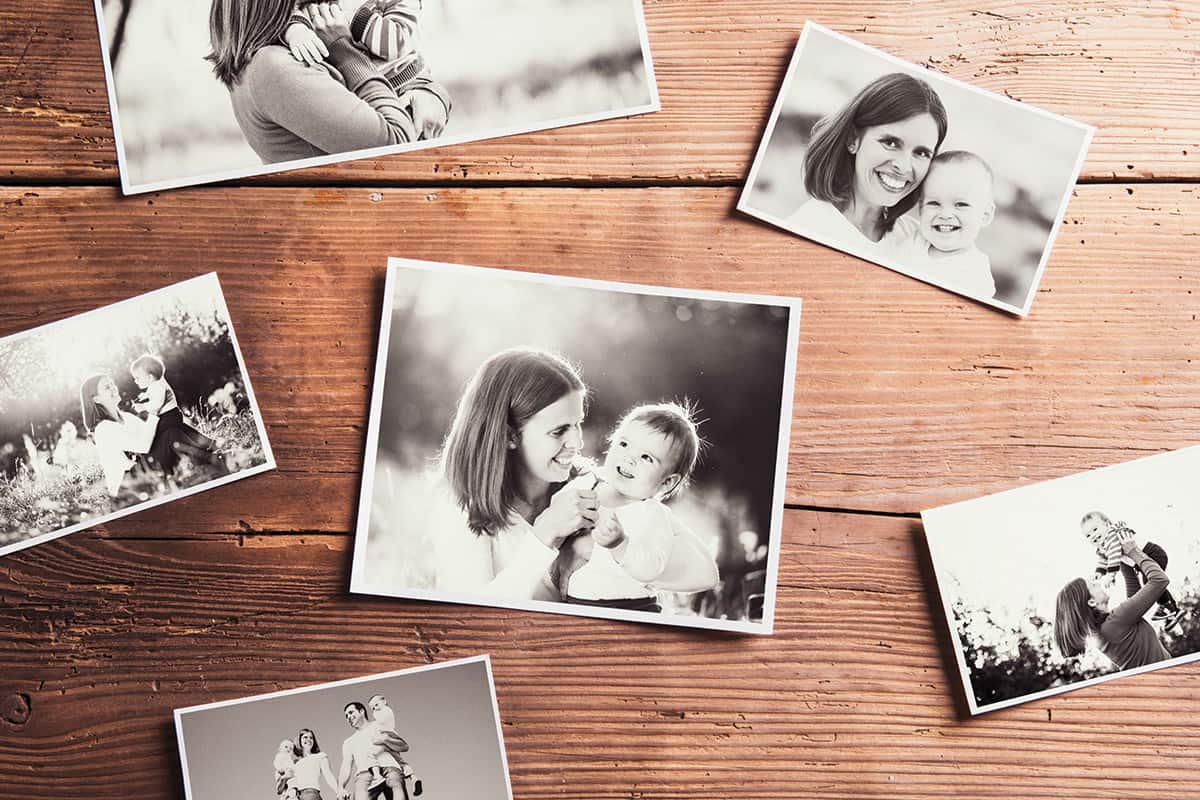By Melissa Snider
–
There are 12,976 photos residing on my iPhone. I count 219 selfies (including many floor shots snapped surreptitiously by my two- and four-and-a-half-year-old daughters), twelve panoramas (one is a view of our living room after playtime—an SOS to my husband), and 435 videos (multiple attempts to re-create some cute moment, while my youngest daughter—who wants to see it—reaches for the phone).
“Make baby albums” has been at the top of my to-do list for years. But the days of developing photos in manageable rolls of twenty-four are long gone. It’s not a unique problem. Today’s families are busy—our days are packed, and so are our memory cards. So the question is, why (and how) should families fit photo organizing into their schedules? I spoke with local photographers Kisa Koenig, Flo McCall, and Jay Goodrich to get their thoughts on this modern-day digital dilemma.
“It took me three years to make a family photo album,” says McCall, a Jackson-based portrait photographer (flomccall.com). According to McCall, “It’s either your time or your money,” when it comes to creating photo albums for your family. Time, to sift through thousands of images and make albums, or money, if you hire a professional.
Koenig, McCall, and Goodrich also share a common concern: Why are we taking so many photos in the first place?
“We’re taking pictures of life events as an observer, rather than a participant,” says Driggs, Idaho-based family and newborn photographer Kisa Koenig (kisakoenig.com). “Being present in what we’re experiencing is so important,” she says, since we often get caught up in our cameras (or phones) instead of the moment. Adventure photojournalist Goodrich (jaygoodrich.com) thinks we’re trying to capture “the heritage of the world,” or, rather, the heritage of OUR world and our place in it.
So, how can we strike the right balance between enjoying the moment and preserving our memories?
Tip 1: Take fewer, more meaningful pictures.
Cutting down on photo clutter reduces anxiety about moving photos from the digital realm into printed reality. Pause and think, “Will I share this shot on social media, or is it one for the ages?” The more you leave your phone in your pocket, the choosier you become. Snap a couple of photos and get back to living life.
Speaking of phones, I often wonder if using mine as a camera is cheating. “If I want a quality picture, I have to take it with a real camera,” McCall says. This is especially important if, later on, you want to enlarge or frame the photo as a gift for a holiday or other occasion.
Tip 2: have family photos taken. Moms, this means you!
Moms, make sure you get into the photo! I know I struggle to ignore the toll sleep deprivation takes on my appearance, but you and your family will be glad to have documented special moments together. Also—I’ll let you in on a big secret—no one else will notice.
To ensure quality shots (with mom included), hire a professional. Keep in mind that Koenig and McCall both recommend letting your photographer guide you through the entire process, including printing and framing the images from the shoot.
Tip 3: Take time to organize and tag, and then back it up.
As a librarian, I thought I’d be awesome at managing my photos. Wrong! I rarely make time to edit or organize pictures. Goodrich adds tags to make photos searchable, and recommends “mastering” shots by playing with your software’s editing tools. McCall agrees. “Take some time each year to edit, toss, collect, and print,” she says. Consider it a New Year’s resolution.
If you’re on a Mac, the easiest management system is iPhoto, with iCloud storage automatically backing up your memories. Other online storage choices include Flickr, Dropbox, Amazon Cloud, or Google Drive. Charges for additional storage can be worth the peace of mind to know your photos are safe.
Tip 4: Find a printing method that works for you.
Our pros agree that photo books will become as much of a mainstay as the old-school albums with peel-back pages. “It’s a big time investment with a big payoff,” McCall says. Goodrich concurs. “I love being able to flip through the pages of a book that tells a story,” he says. “I love the smell of the ink and the paper.”
But true to their photography roots, these pros also love the classic look of a framed image. When printing, choose archival or acid-free paper and albums to ensure the photo will stand the test of time. Also remember that the low-resolution photos from your phone should be printed 5 x 7 inches or smaller, to maintain quality.
As with all things nowadays, you’ve got too many choices and not enough time when it comes to options for printing and displaying your photos. Consider the following ideas for inspiration:
Annual Photo Books
My friend Addie Pascal makes a narrative photo book for every year of her marriage. I especially love her idea of gluing an envelope into the back of each book to store that year’s family Christmas card, kids’ class photos, and other clippings worth saving.
Framed and Canvas Prints
Many companies will print the photo and frame it for you; just order and check it off your list. If you’re looking for a polished but unframed piece, try printing on canvas (blossompix.com). Canvas prints are more expensive than paper, but “they’re classic,” according to Koenig. “They’re ready to hang, there’s no glass so they’re easier to ship, and they’re a bit forgiving if you try to print something bigger than it can handle.”
Digital Frame
My colleague Grace Hammond displays more than 2,000 photos in her home with a single Wi-Fi-enabled frame called a Nixplay (nixplay.com). She texts favorite photos to the frame and, voila, they’re on display. Her twin toddlers love reliving adventures and waving to grandparents as they watch photos flash by.
For the Kids
Koenig, Goodrich, and McCall all recommend getting photos of your kids up on the wall, and have tried to do this in their own homes. McCall says her children love it when she puts photos in their rooms. “It makes them feel good,” she says. “It helps them form an idea of who they are and what their life is; it makes them happy.”
–
Images transport and inspire us, and can be a touchstone to the past. Taking time to mindfully record your family’s life in photos is an important investment, one that you can enjoy now and pass on to future generations.
Sharing the Love
–
Unique Ideas for Printed Keepsakes …
Accordion Minis
Miniature (2.5 x 3.5 inches), and adorable, accordion minis make super keepsakes or gifts. Design with six to fifteen photos; prices start at $19.99. mpix.com
Photostrips
Photostrips offer a retro way to showcase your favorite shots. Nine strips (measuring 1.9 x 7.3 inches) with thirty-six photos total cost $10. Or try a giant photostrip (9 x 36 inches) for your high-resolution shots—eight photos on two strips for $20. socialprintstudio.com
Board Books
Think first birthdays, family photos, or favorite places. Your kids will proudly reach for these again and again. Work with templates or customize from scratch. Prices range from $24.95 to $34.95, plus shipping. pintsizeproductions.com or pinholepress.com
There’s an App for That …
Mpix (mpix.com)
Mpix offers a range of high-quality photo keepsakes, gifts, and prints.
Chatbooks (chatbooks.com)
Set up a subscription to automatically print inexpensive books from your Instagram, Facebook, or Camera Roll photos.
Or Go Local …
D.D. Camera Corral, Jackson (ddcameracorral.com)
Prints and other photo products are available in-store, or send files for pickup through their website or the D.D. Camera Corral app.
Peak Printing, Driggs, Idaho (peakprinting.net)
Photo printing and products available in-store.





